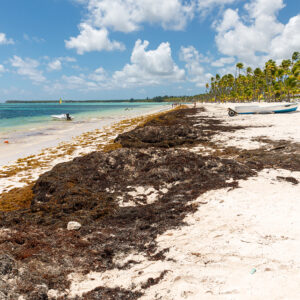Are you planning to travel to the Caribbean? Have fun, but beware of the sargassum. What? That’s the ugly seaweed piling up along the Mexican and Caribbean shorelines — a byproduct of warming oceans and climate change.
Sargassum turns those beaches into landfills, which could sink the tourism economies of those communities. Rising water temperatures cause chemicals to bleed into the ocean and kill biodiversity. It is threatening to do the same in Florida. Indeed, no place is off limits to warming trends.
“While climate change is not one of the top concerns, our people are seeing its side effects: hurricanes, the amount of sargassum on the beaches, and the level of beach erosion,” said Milagros De Camps, vice minister for climate change and sustainability for the Dominican Republic.
During a visit to one of the Dominican Republic’s resorts, I saw companies with heavy equipment raking up and dispensing endless amounts of sargassum. The University of South Florida said sargassum levels are at record levels. Worse still, it will continue to get bigger and potentially migrate toward Florida.
The Dominican Republic’s gross national product is 3 percent to 5 percent annually, driven in considerable measure by tourism. It also has tropical rainforests that absorb atmospheric carbon dioxide. The island’s beaches occupy 1,500 square kilometers of coastline. But its rainforests are 18,000 square kilometers, making up 43 percent of the country — up from 11 percent between 1960 and 1980.
If those trees remain standing, they will continue to fight climate change and protect the beaches. However, those trees have competing interests — from farmers and loggers, generating revenues and jobs.
Since 2009, the developed countries have promised financing to less developed countries. After all, the more affluent countries contribute the most to the world’s carbon emissions. Meanwhile, the rainforest nations contribute the least but suffer the most from extreme weather, such as hurricanes and flooding.
St. Lucia is now the world’s top-rated honeymoon destination. But, sargassum plagues the island. It can pile 20 feet high in some places. That’s why the United Nations Development Program gave it $2 million under its Project for Improving National Sargassum Management Capacities in the Caribbean.
St. Lucia has dry and wet seasons. From November to May, it is dry and hot; from June to October, it is rainy, creating flooding conditions. But the weather has become erratic over the last five years — conditions with heavy downfalls and severe flooding year-round. Eight tropical storms have hit the island in the previous year. It’s a matter of time before hurricane-strength winds arrive.
Climate events could upend the island. For starters, sargassum litters its beaches, threatening tourism and hurting its fishermen. Indeed, unsightly seaweed deters visitors and entangles fishing equipment. Beaches have been closed during massive cleanups.
There’s some good news. The island has 79,000 acres of forests. About 61,700 acres of that is nationally protected. Forests cover 60 percent of the country — trees that sequester carbon, store water and block hurricane winds.
The island is almost carbon-negative, absorbing nearly as much carbon dioxide as it emits. That may allow it to sell carbon credits to companies and countries — a win-win. St. Lucia will have money to fight climate change while countries can offset their emissions until they deploy more green energies.
“We want the bigger emitters to see that the smaller islands are doing their part,” said Rebecca Rock, St. Lucia’s deputy chief of the forest. “We have done this ourselves and without international help. Hopefully, we will receive some international funding.”
If you visit the Caribbean between now and summer’s end, don’t bury your head in the sand — impossible to do because the sargassum is impossible to avoid. Realize it’s a manifestation of climate change, requiring recognition of rainforest nations’ role and a fundamental shift toward sustainable fuels.


